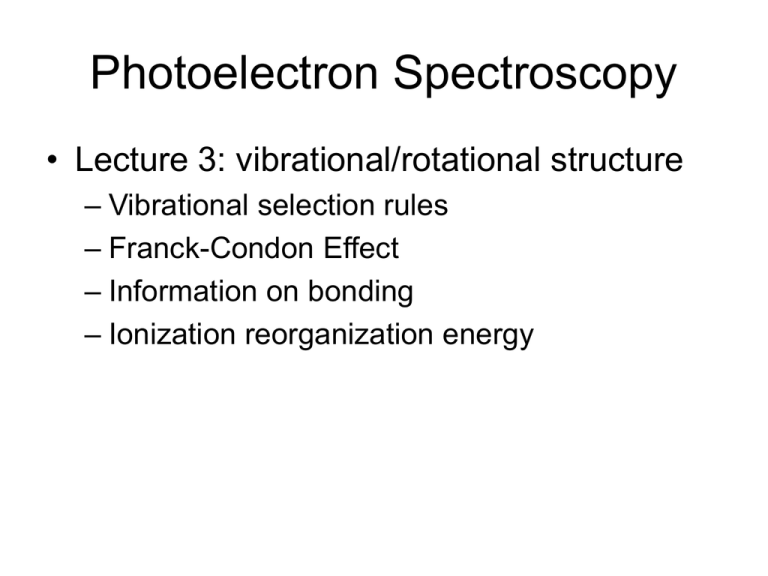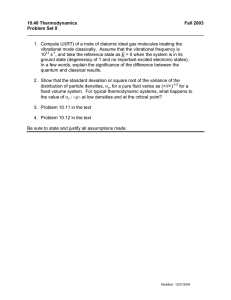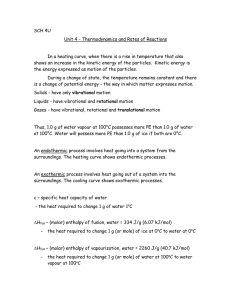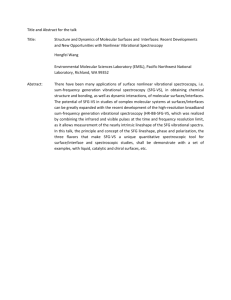Ionization Band Shapes
advertisement

Photoelectron Spectroscopy • Lecture 3: vibrational/rotational structure – Vibrational selection rules – Franck-Condon Effect – Information on bonding – Ionization reorganization energy Potential Energy Surface Description of the Ionization of Dihydrogen Ionization Energy (eV) 18 H2+ 17 16 15 H2 0 0 1 r (Å) 2 Much more on this next time!! Note: this is not vibronic coupling! • In electronic absorption spectroscopy, vibronic coupling refers to vibrational lowering of symmetry, which makes forbidden electronic transitions allowed. • Direct ionization transitions are already always allowed. Vibrational Overlap Integral The specific intensities of the different vibrational components are governed by the Franck-Condon Principle and are expressed by the vibrational overlap integral: I S' vib *S vib dR Svib is the vibrational wavefunction in the ground state S’vib is the vibrational wavefunction in the excited state. The square of the vibrational overlap integral in called the Franck-Condon factor. Vibrational Selection Rules • Most molecules exist in the totally symmetric zero-point vibrational level of the ground state • Totally symmetric modes of the ionic state are therefore observed. • If the vibrational levels have quantum numbers n, then the selection rule is Δn = 0, ±1, ±2, etc. • In other words, transitions between any vibrational levels of the ground electronic state and excited electronic state(s) for any totally symmetric vibration will be allowed. • For large molecules, structure for several symmetric modes may be interdigitated Vertical Ionization is the most probable Ionization Energy (eV) 18 H2 + 17 vertical adiabatic 16 15 Lowest energy transition: Adiabatic transition (ν0 ➔ ν0) Most probable (tallest) transition: Vertical transition H2 0 0 1 r (Å) 2 Ground state vibrational population follows a Boltzmann distribution: e-E/kT kT at room temperature is 0.035 eV (300 cm-1) Bond Character of Orbitals 2u :N≡N: 1g 2p 2p 2g (N-N) cm-1 Ground state 2330 1st ion state 2100 2nd ion state 1810 3rd ion state 2340 1u 2s 1u 2s 1g Ground state = 1g+ First ion state = 2g+ Second ion state = 2u Third ion state = 2 20 19 18 17 16 Ionization Energy (eV) 15 Will vibrational structure be observed on core ionizations? Bancroft, Inorg. Chem. 1999, 38, 4688. Svensson, J. Chem. Phys. 1997, 106, 1661. Core equivalent model “Atomic cores that have the same charge may be considered to be chemically equivalent” W.L. Jolly, Acc. Chem. Res. 1970. • Removing a core electron is equivalent to adding a proton to the nucleus – Core-ionized atom Z is equivalent to atom Z+1 • Eg., core-ionized CH4 is equivalent to NH4+ – In CH4 C-H = 1.09 Å, in NH4+ N-H = 1.01 Å – Therefore potential well is shifted for core ionization, and vibrational transitions other than 0 to 0 will be observed • Core-ionized W(CO)6 is equivalent to Re(CO)6+ – W(CO)6 W-C = 2.07 Å, Re(CO)6+ Re-C = 2.01 Å Quantitative Measure of Geometry Changes In a harmonic oscillator model, the intensities of the individual vibrational components (Franck-Condon factors) will follow a Poisson distribution: S n S In e n! S = distortion parameter (Huang-Rhys factor) Width of ionization envelope indicates amount of geometry change between ground state and ion state. Modeling of band shape to analyze S and the vibrational frequencies allows us to quantitate geometry change, reorganization energy, etc. Example: Nitric Oxide NO <2 1+ <1 <3 <0 h for neutral NO is 1,890 cm-1 vibrational spacing here is 2,260 cm-1 <4 <6 <5 11.5 11.0 10.5 10.0 9.5 Ionization Energy (eV) Quanta Rel. FC 0 51 1 100 2 93 3 52 4 21 5 6 6 2 S n S In e n! These can be related by an S of 1.8. S 1 2 k (Q) 2 h Solving for Q allows us to estimate that the NO distance has changed by 0.085 Å in the ion state. Must be a shortening of NO distance to account for increase in vibrational frequency Reorganization Energy A t2 t1 B Factors Controlling Electron-Transfer Reactions Rates • G°, the free energy change • Hab (or t), electronic coupling • , the reorganization energy = i + o, inner-sphere and outer-sphere contributions i: vibrational reorganization energy, hole-phonon coupling Reorganization Energy +● +● + + +● 8•+ 80 Distortion Coordinate Reorganization Energy S n S In e n! h = 173.3 meV (1,400 cm-1) S = 0.358 h = 42.3 meV (340 cm-1) S = 0.182 = (hk)•(Sk) 7.9 7.7 7.5 Ionization Energy (eV) •+ =69.7 meV 8 7.3 Unresolved Vibrational Structure Photoelectron spectra of larger molecules usually look more like this: How should we analyze data like these? Spectral fitting with consideration for chemical implications. Summary • Ionization from electronic levels includes transitions to discrete vibrational/rotational levels. • Bonding character of individual electrons gives rise to ionization band structure. • This band structure can be analyzed to give quantitative information on geometry changes, reorganization energies – bonding. • If vibrational structure is not resolved, ionization bands will still have a shape related to bonding differences.





